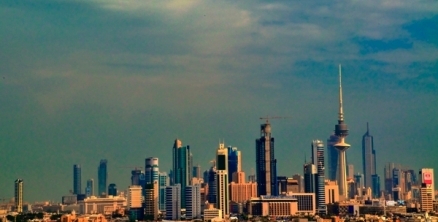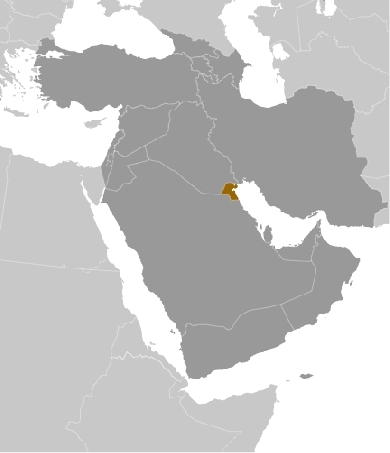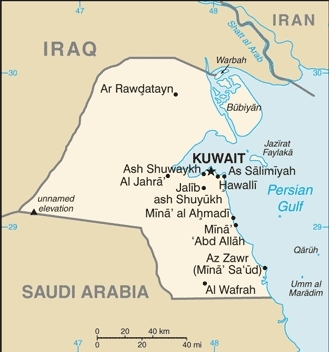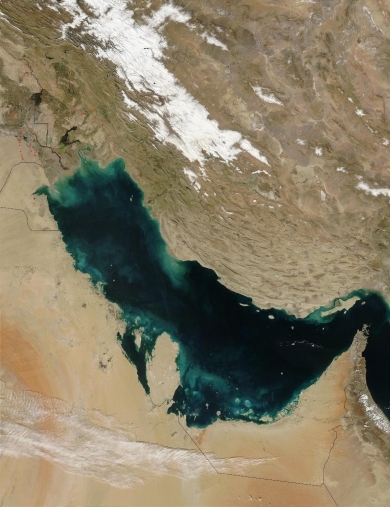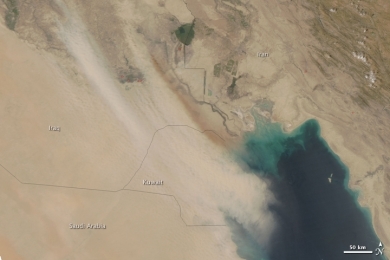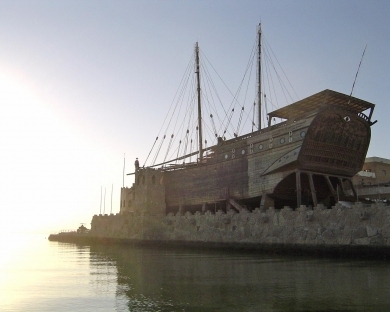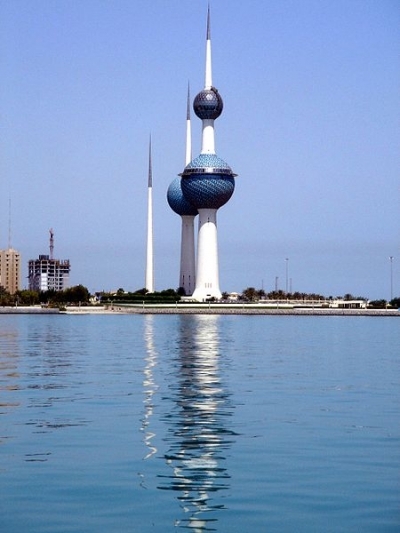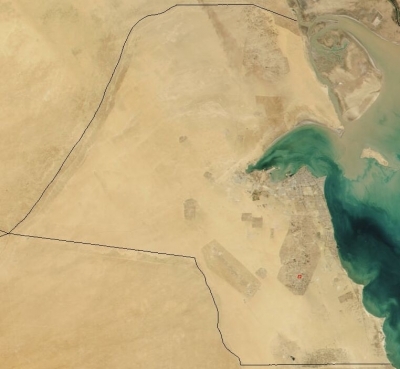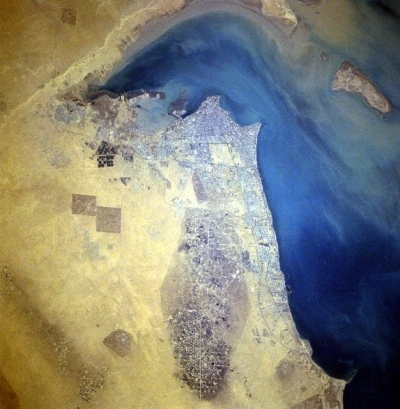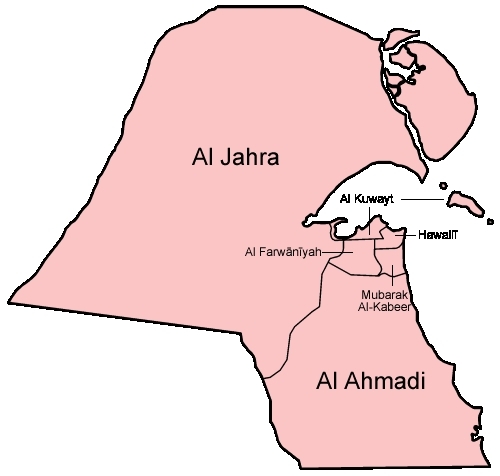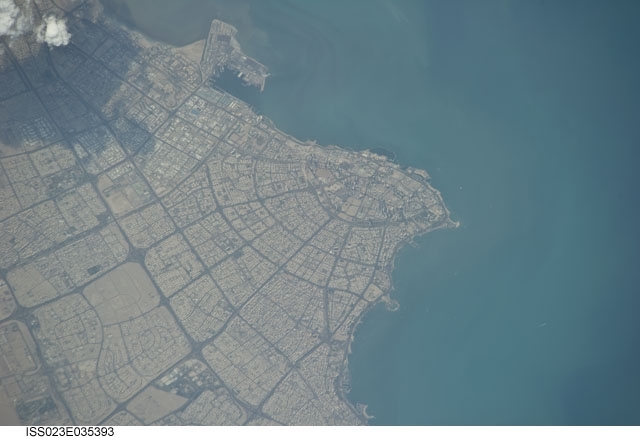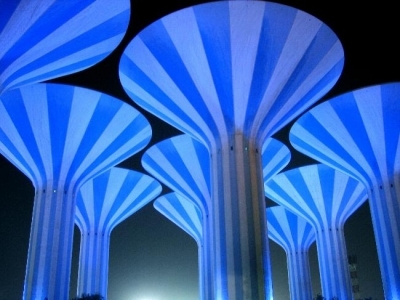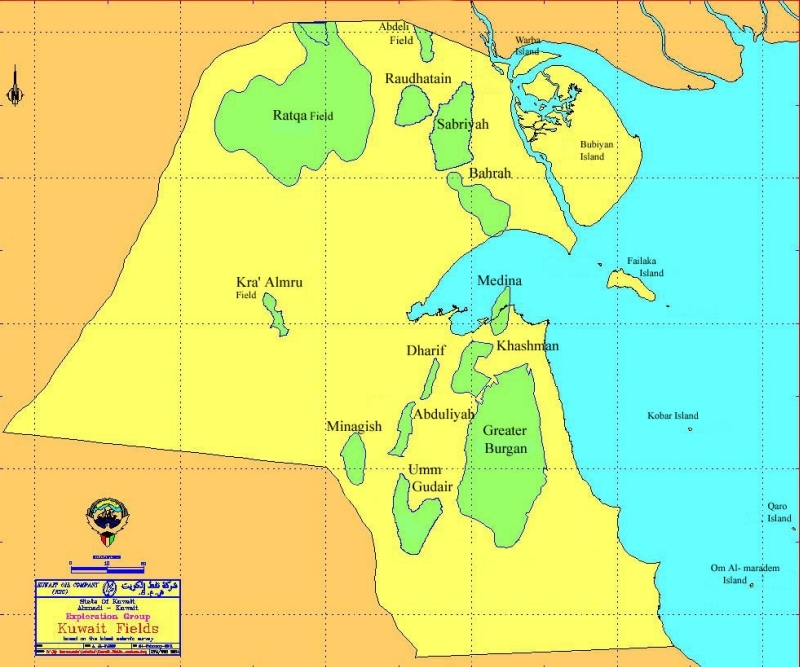Kuwait (About the EoE)
Contents
Kuwait
Kuwait is a nation in the Middle East, bordering the Persian Gulf, between Iraq and Saudi Arabia. About a half of its population of 2.6 million people is composed of non-nationals.
Its major environmental issues include:
- limited natural freshwater resources - some of world's largest and most sophisticated desalination facilities provide much of the water;
- air and water pollution;
- desertification
Britain oversaw foreign relations and defense for the ruling Kuwaiti Al-Sabah dynasty from 1899 until independence in 1961.
Kuwait was attacked and overrun by Iraq on 2 August 1990. Following several weeks of aerial bombardment, a US-led, UN coalition began a ground assault on 23 February 1991 that liberated Kuwait in four days. Kuwait spent more than $5 billion to repair oil infrastructure damaged during 1990-91.
The Al-Sabah family has ruled since returning to power in 1991 and reestablished an elected legislature that in recent years has become increasingly assertive.
The country witnessed the historic election in May 2009 of four women to its National Assembly.
Amid the 2010-11 uprisings and protests across the Arab world, stateless Arabs, known as bidoon, staged small protests in February and March 2011 demanding citizenship, jobs, and other benefits available to Kuwaiti nationals. Youth activist groups - supported by opposition legislators and the prime minister's rivals within the ruling family - rallied in March 2011 for an end to corruption and the ouster of the prime minister and his cabinet. Similar protests continued sporadically throughout April and May. In late September 2011 government inquiries of widespread corruption drew more public anger and renewed calls for the prime minister's removal.
Kuwait has a strategic location at head of the Persian Gulf. Kuwait and Saudi Arabia continue negotiating a joint maritime boundary with Iran. No maritime boundary exists with Iraq in the Persian Gulf
Geography
Location: Middle East, bordering the Persian Gulf, between Iraq and Saudi Arabia
Geographic Coordinates: 29 30 N, 45 45 E
Area: 17,818 sq km
Land Boundaries: 462 km (Iraq 240 km, Saudi Arabia 222 km)
Coastline: 499 km
Maritime Claims: territorial sea: 12 nm
Natural Hazards: sudden cloudbursts are common from October to April and bring heavy rain, which can damage roads and houses; sandstorms and dust storms occur throughout the year but are most common between March and August
Terrain: flat to slightly undulating desert plain. The highest point is an unnamed elevation (306 m).
Climate: dry desert; intensely hot summers; short, cool winters
Ecology and Biodiversity
Ecologically, Kuwait in within the Persian Gulf desert and semi-desert ecoregion. See also: Arabian Sea large marine ecosystem.
People and Society
Over 90% of the population lives within a 500-square kilometer area surrounding Kuwait City and its harbor. Although the majority of people residing in the State of Kuwait are of Arab origin, fewer than half are originally from the Arabian Peninsula. The discovery of oil in 1938 drew many Arabs from nearby states. Following the liberation of Kuwait from Iraqi occupation in 1991, the Kuwaiti Government undertook a serious effort to reduce the expatriate population by specifically limiting the entry of workers from nations whose leaders had supported Iraq during the Gulf War. Kuwait later abandoned this policy, and it has a sizable foreign labor force (approximately 68% of the total population is non-Kuwaiti).
Population: 2,646,314 (July 2012 est.) which includes note: includes 1,291,354 non-nationals
| Much of the sediment clouding the water in this image of the Persian Gulf is from the Shatt al Arab River, which enters the Gulf in the north along the Iran-Iraq border. The river drains the combined waters of the Euphrates and Tigris Rivers of Iraq, and the Karun River of Iran. Though other rivers empty into the Persian Gulf, most of its fresh water comes from the Shatt al Arab. On the right edge of the image is the narrow Strait of Hormuz, which connects the Persian Gulf to the Arabian Sea, part of the northern Indian Ocean. The Persian Gulf is flanked to the west by wedge-shaped Kuwait and by Saudi Arabia with its vast tan-, pink-, and white-sand deserts; to the south by Qatar, the United Arab Emirates, and Oman; and to the east by the dry mountains of Iran. The wetlands and rivers of Mesopotamia border the Gulf on the north. The red dots mark gas flares in oil fields of Iran and Iraq. Image courtesy of NASA. |
|
Thick clouds of dust blew from the agricultural lands between the Euphrates and Tigris Rivers in Iraq on August 15, 2009. The pale dust obscures most of Kuwait and culminates in a distinct plume over the Persian (Arabian) Gulf. One plume on the east side of the storm is darker than the rest of the airborne dust. This plume either comes from a different type of source—exposed agricultural soil instead of desert, perhaps—or it is a plume of smoke from a fire. Red dots mark where the Moderate Resolution Imaging Spectroradiometer (MODIS) detected fires, but in this case, a fire may be hidden from the sensor by the dust storm. Ongoing drought may be contributing to the frequent and severe dust storms Iraq has experienced in 2009. The MODIS sensor flying on NASA’s Aqua satellite captured this image on August 15, 2009. NASA image courtesy the MODIS Rapid Response Team at NASA GSFC. Caption by Holli Riebeek. |
| Dhows (Arab sailing vessels) played a prominent role in Kuwait's maritime history, and were used in trade, fishing, and pearling. This restored example is on display in Kuwait City. |
| Kuwait Towers, a notable landmark. Source: Wikimedia Commons. |
|
Satellite view of Kuwait. Source: NASA |
| Kuwait City (1996). Source: NASA |
Ethnic Groups: Kuwaiti 45%, other Arab 35%, South Asian 9%, Iranian 4%, other 7%
Age Structure:
0-14 years: 25.8% (male 348,816/female 321,565)
15-64 years: 72.2% (male 1,153,433/female 720,392)
65 years and over: 2% (male 25,443/female 25,979) (2011 est.)
Population Growth Rate: 1.883% Note: this rate reflects a return to pre-Gulf crisis immigration of expatriates (2012 est.).
Birthrate: 20.96 births/1,000 population (2012 est.)
Death Rate: 2.13 deaths/1,000 population (July 2012 est.)
Net Migration Rate: 0 migrant(s)/1,000 population (2012 est.)
Life Expectancy at Birth: 77.28 years
male: 76.09 years
female: 78.51 years (2012 est.)
Total Fertility Rate: 2.6 children born/woman (2012 est.)
Languages: Arabic (official), English widely spoken
Literacy (age 15 and over can read and write): 93.3% (2005 census). Kuwait's 93.3% literacy rate, one of the Arab world's highest, is the result of extensive government support for the education system. Public school education, including Kuwait University, is free, but access is restricted for foreign residents. The government sponsors the foreign study of qualified students abroad for degrees not offered at Kuwait University. In 2009, approximately 3,318 Kuwaitis were enrolled in U.S. universities.
Urbanization: 98% of total population (2010) growing at an annual rate of change of 2.1% (2010-15 est.)
History
Archaeological finds on Failaka, the largest of Kuwait's nine islands, suggest that Failaka was a trading post at the time of the ancient Sumerians. Failaka appears to have continued to serve as a market for approximately 2,000 years, and was known to the ancient Greeks. Despite its long history as a market and sanctuary for traders, Failaka appears to have been abandoned as a permanent settlement in the 1st century A.D. Kuwait's modern history began in the 18th century with the founding of the city of Kuwait by the Uteiba, a subsection of the Anaiza tribe, who are believed to have traveled north from Qatar.
Threatened in the 19th century by the Ottoman Turks and various powerful Arabian Peninsula groups, Kuwait sought the same treaty relationship Britain had already signed with the Trucial States (U.A.E.) and Bahrain. In January 1899, the ruler Sheikh Mubarak Al Sabah--"the Great"--signed an agreement with the British Government that pledged himself and his successors neither to cede any territory, nor to receive agents or representatives of any foreign power without the British Government's consent, in exchange for protection and an annual subsidy. When Mubarak died in 1915, the population of Kuwait of about 35,000 was heavily dependent on shipbuilding (using wood imported from India) and pearl diving.
Mubarak was succeeded as ruler by his sons Jabir (1915-17) and Salim (1917-21). Kuwait's subsequent rulers have descended from these two brothers. Sheikh Ahmed al-Jabir Al Sabah ruled Kuwait from 1921 until his death in 1950, a period in which oil was discovered and in which the government attempted to establish the first internationally recognized boundaries; the 1922 Treaty of Uqair set Kuwait's border with Saudi Arabia and also established the Kuwait-Saudi Arabia Neutral Zone, an area of about 5,180 sq. km. (2,000 sq. mi.) adjoining Kuwait's southern border.
Kuwait achieved independence from the British under Sheikh Ahmed's successor, Sheikh Abdullah al-Salim Al Sabah. By early 1961, the British had already withdrawn their special court system, which handled the cases of foreigners resident in Kuwait, and the Kuwaiti Government began to exercise legal jurisdiction under new laws drawn up by an Egyptian jurist. On June 19, 1961, Kuwait became fully independent following an exchange of notes with the United Kingdom.
Kuwait enjoyed an unprecedented period of prosperity under Amir Sabah al-Salim Al Sabah, who died in 1977 after ruling for 12 years. Under his rule, Kuwait and Saudi Arabia signed an agreement dividing the Neutral Zone (now called the Divided Zone) and demarcating a new international boundary. Both countries share equally the Divided Zone's petroleum, onshore and offshore. The country was transformed into a highly developed welfare state with a free market economy.
In August 1990, Iraq attacked and invaded Kuwait. Kuwait's northern border with Iraq dates from an agreement reached with Turkey in 1913. Iraq accepted this claim in 1932 upon its independence from Turkey. However, following Kuwait's independence in 1961, Iraq claimed Kuwait, arguing that Kuwait had been part of the Ottoman Empire subject to Iraqi suzerainty. In 1963, Iraq reaffirmed its acceptance of Kuwaiti sovereignty and the boundary it agreed to in 1913 and 1932, in the "Agreed Minutes between the State of Kuwait and the Republic of Iraq Regarding the Restoration of Friendly Relations, Recognition, and Related Matters."
Following several weeks of aerial bombardment, a UN-mandated coalition led by the United States began a ground assault in February 1991 that liberated Kuwait. During the 7-month occupation by Iraq, the Amir, the Government of Kuwait, and many Kuwaitis took refuge in Saudi Arabia and other nations. The Amir and the government successfully managed Kuwaiti affairs from Saudi Arabia, London, and elsewhere during the period, relying on substantial Kuwaiti investments available outside Kuwait for funding and war-related expenses.
Following liberation, the UN, under Security Council Resolution 687, demarcated the Iraq-Kuwait boundary on the basis of the 1932 and 1963 agreements between the two states. In November 1994, Iraq formally accepted the UN-demarcated border with Kuwait, which had been further spelled out in UN Security Council Resolutions 773 and 883. Despite these steps, bilateral relations between Kuwait and Iraq continued to be troubled into 2010 by unresolved problems related to border demarcation, debt, reparations, and the return of missing persons and archives seized during the 1990 invasion.
Government
Kuwait is a constitutional, hereditary emirate ruled by princes (Amirs) who have been drawn from the Al Sabah family since the middle of the 18th century. The 1962 constitution provides for an elected National Assembly and details the powers of the branches of government and the rights of citizens. Under the Constitution, the National Assembly has a limited role in approving the Amir's choice of the Crown Prince, who succeeds the Amir upon his death. If the National Assembly rejects his nominee, the Amir then submits three names of qualified candidates from among the direct descendants of Mubarak the Great, the founder of modern Kuwait, from which the Assembly must choose the new Crown Prince. Successions have been orderly since independence. In January 2006, the National Assembly played a symbolically important role in the succession process, which was seen as an assertion of parliament's constitutional powers.
For almost 40 years, the Amir appointed the Crown Prince as Kuwait's Prime Minister. However, in July 2003, the Amir formally separated the two positions and appointed a different ruling family member as Prime Minister.
Kuwait's first National Assembly was elected in 1963, with follow-on elections held in 1967, 1971, and 1975. From 1976 to 1981, the National Assembly was suspended. Following elections in 1981 and 1985, the National Assembly was again dissolved. Fulfilling a promise made during the period of Iraqi occupation, the Amir held new elections for the National Assembly in 1992. In 1999, 2006, 2008, 2009, and December 2011, the Amir dissolved the National Assembly, but complied with the constitution by holding new elections within 60 days. The February 2012 parliamentary elections were free and fair. While women participated for the fourth time as voters and candidates, no women were elected to the parliament for the first time since 2009.
The February 2012 parliamentary elections were the third held under a five-constituency system in place since 2006. The government does not officially recognize political parties; however, de facto political blocs, typically organized along ideological lines, exist and are active in the National Assembly. Although the Amir maintains the final word on most government policies, the National Assembly plays a real role in decision-making, with powers to initiate legislation, interpellate ("grill") cabinet ministers, and conduct a vote of no-confidence for individual ministers. For example, in 1999, the Amir issued several landmark decrees dealing with women's suffrage, economic liberalization, and nationality. The National Assembly later rejected all of these decrees as a matter of principle and then reintroduced most of them as parliamentary legislation.
|
Government Type: constitutional emirate Capital: Kuwait City 2.23 million (2009) Administrative divisions: 6 governorates (muhafazat, singular - muhafazah);
Map source: Wikimedia Commons. Independence Date: 19 June 1961 (from the UK) Legal System: mixed legal system consisting of English common law, French civil law, and Islamic religious law. Kuwait has not submitted an International Court of Justice (ICJ) jurisdiction declaration; and is a non-party state to the International Criminal Court (ICCt). |
International Environmental Agreements
Kuwait is party to international agrements on Biodiversity, Climate Change, Climate Change-Kyoto Protocol, Desertification, Endangered Species, Environmental Modification, Hazardous Wastes, Law of the Sea, Ozone Layer Protection. It has signed, but not ratified an international agrement on Marine Dumping.
Water
Total Renewable Water Resources: 0.02 cu km (1997)
Freshwater Withdrawal: 0.44 cu km/yr (45% domestic, 2% industrial, 52% agricultural)
Per Capita Freshwater Withdrawal: 164 cu m/yr (2000)
Agriculture
Agriculture is limited by the lack of water and arable land. The government has experimented in growing food through hydroponics and carefully managed farms. However, much of the soil that was suitable for farming in south central Kuwait was destroyed when Iraqi troops set fire to oil wells in the area and created vast "oil lakes." Fish and shrimp are plentiful in territorial waters, and large-scale commercial fishing has been undertaken locally and in the Indian Ocean.
Agricultural products: fish
Irrigated Land: 100 sq km (2008)
Resources
Natural Resources: petroleum, fish, shrimp, natural gas
Land Use:
arable land: 0.84%
permanent crops: 0.17%
other: 98.99% (2005)
Astronuat photograph of Kuwait City (May 7, 2010). Source: NASA
Economy
Kuwait has a geographically small, but wealthy, relatively open economy with self-reported crude oil reserves of about 102 billion barrels - about 9% of world reserves. Petroleum accounts for nearly half of GDP, 95% of export revenues, and 95% of government income. Kuwaiti officials have committed to increasing oil production to 4 million barrels per day by 2020. See: Energy profile of Kuwait
The rise in global oil prices throughout 2011 is reviving government consumption and economic growth. Kuwait has experienced a 20% increase in government budget revenue, which has led to higher budget expenditures, particularly wage hikes for many public sector employees.
| "Mushrooms" in the desert: water towers in Kuwait. |
Kuwait has done little to diversify its economy, in part, because of this positive fiscal situation, and, in part, due to the poor business climate and the acrimonious relationship between the National Assembly and the executive branch, which has stymied most movement on economic reforms. In 2010, Kuwait passed an economic development plan that pledges to spend up to $130 billion over five years to diversify the economy away from oil, attract more investment, and boost private sector participation in the economy.
Oil
In 1934, the ruler of Kuwait granted an oil concession to the Kuwait Oil Company (KOC), jointly owned by the British Petroleum Company and the Gulf Oil Corporation. In 1976, the Kuwaiti Government nationalized KOC. The following year, Kuwait took over part of onshore production in the Divided Zone between Kuwait and Saudi Arabia. Kuwait Gulf Oil Company (KGOC) produces jointly there with Saudi Arabian Chevron, which, by its 1984 purchase of Getty Oil Company, acquired the Saudi Arabian onshore concession in the Divided Zone. Saudi Arabia renewed Chevron's concession in the Divided Zone for another 30 years, effective from February 2009. KGOC also manages offshore production operations, while Aramco Gulf Oil Company (AGOC) manages the Saudi portion of the offshore Divided Zone.
Kuwait Petroleum Corporation (KPC), an integrated, state-owned oil company, is the parent company of the government's operating companies in the petroleum sector. It includes Kuwait Oil Company, which produces oil and gas; Kuwait National Petroleum Company, which manages refining and domestic sales; Petrochemical Industries Company, which produces ammonia, urea, ethylene, propylene, and styrene and participates in a number of successful joint ventures with Dow Chemical within Kuwait and abroad; Kuwait Foreign Petroleum Exploration Company, which is responsible for exploration and upstream production outside Kuwait (in several developing countries and Australia); Kuwait Oil Tanker Company; Kuwait Gulf Oil Company, responsible for exploration and production in the Kuwait portions of the offshore and onshore Divided Zone; and Kuwait Petroleum International, which manages refining and retail operations outside Kuwait (in Europe and East Asia).
According to official Organization of Petroleum Exporting Countries (OPEC) figures, Kuwait has approximately 101.5 billion barrels of proven oil reserves (including the Kuwaiti share of proven reserves in the Divided Zone), the fifth-largest oil reserves in the world after Saudi Arabia, Canada, Iran, and Iraq. By 1993, Kuwait had restored its oil production capacity to its pre-occupation levels of 2.4 million bpd. Kuwait's current oil production capacity is estimated at 3 million bpd. Kuwait plans to increase its capacity to 3.5 million bpd by 2015 and 4.0 million bpd by 2020. Many analysts question whether these goals are feasible. Kuwaiti export crude averaged $82 per barrel in 2010.
Oil Fields of Kuwait. Source: Ministry of Oil, Kuwait.
KPC purchased refineries in the Netherlands and Italy and service stations in the Benelux nations, Italy, and Scandinavia from Gulf Oil Company. In 1987, KPC bought a 19% share in British Petroleum, which was later reduced to 10%. KPC markets its products in Europe under the brand name Q8. In 2006, KPC announced plans to participate in a joint venture to build and operate a refinery and associated petrochemical plant in China. In April 2008, KPC signed a joint venture agreement with Idemitsu Kosan-Japan to hold a 35.1% stake, worth $6 billion, of Vietnam's second refinery. Both projects are pending processing of domestic licenses.
In 2008, KPC awarded a $14 billion project to construct a fourth refinery to several international firms. The project was to increase refining capacity from 930,000 barrels per day to 1.5 million barrels per day by 2012. However, this project was canceled in March 2009. Under political pressure, the tendering process was reviewed and found illegitimate, as it was not awarded under the Central Tenders Committee bidding process. As of now, the fourth refinery has not been retendered.
Social Benefits
The government has sponsored many social welfare, public works, and development plans financed with oil and investment revenues. Among the benefits for Kuwaiti citizens are retirement income, marriage bonuses, housing loans, virtually guaranteed employment, free medical services, and education at all levels. By Amiri decree, the government occasionally disburses a portion of its budget surplus as a grant to all Kuwaiti citizens. In 2006, an Amiri grant of 200 Kuwaiti dinars (approximately $700) was paid to every citizen who applied. In 2007, the government implemented a debt forgiveness scheme for Kuwaiti citizens amounting to just over $1 billion. In February 2011, the government announced an Amiri grant of estimated 1.5 billion Kuwaiti dinars (approximately $5.3 billion), including 1,000 Kuwaiti dinars (approximately $3,500) to be paid to every citizen along with free monthly food baskets to each Kuwaiti family for 14 months. Foreign nationals residing in Kuwait do not have access to these welfare services. The right to own stock in publicly traded companies, real estate, and banks or a majority interest in a business is limited to Kuwaiti citizens and citizens of Gulf Cooperation Council (GCC) countries under limited circumstances.
GDP: (Purchasing Power Parity): $149.8 billion (2011 est.)
GDP: (Official Exchange Rate): $171.1 billion (2011 est.)
GDP- per capita (PPP): $40,700 (2011 est.)
GDP- composition by sector:
agriculture: 0.3%
industry: 48%
services: 51.8% (2011 est.)
Industries: petroleum, petrochemicals, cement, shipbuilding and repair, water desalination, food processing, construction materials
Currency: Kuwaiti dinars (KD)
